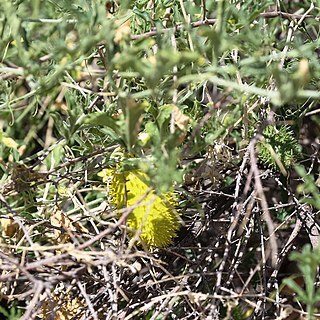Monoecious, mostly scabrous, perennial herb, rootstock woody. Stems procumbent, up to 2 m long. Leaves outline broadly ovate, base cordate, up to 115 x 75 mm, palmately 3-lobed; margins serrate; lobes ± elliptic, central lobe longest; petioles up to 85 mm long. Tendrils simple. Flowers bright yellow. Male flowers sessile, in 5-10-flowered racemes; pedicels 3-13 mm long; receptacle tube funnel-shaped, 3.5-6.5 mm long; lobes triangular, 1-3 mm long; corolla funnel-shaped, glabrous inside; tube 1.5-3.0 mm long; lobes ± ovate, 2.0-5.5 mm long. Female flowers solitary, pedicel 12-34 mm long; receptacle tube 9-19 mm long, aculeate to hispidulous outside, glabrous inside; lobes linear, 1.5-4.0 mm long; corolla ± glabrous inside; tube 1-3 mm long; lobes elliptic, 5-8 mm long. Flowering time Dec.-Mar. Fruit 30-80 mm long, aculei 1-7 mm long; non-bitter, edible. Seeds elliptic, 4-5 mm long.
A pumpkin family herb. It keeps growing from year to year. It is a straggling plant with a rough surface. The leaves have 3-5 lobes. The middle lobe is largest. The tendrils are short and weak. The leaves are 8 cm long on stalks 7 cm long. The female flowers are yellow and 2 cm long. The male flowers are smaller and in clusters. The fruit are oval and 8 cm long by 4 cm across. They are yellow when ripe. The fruit are covered with stiff spines. Some fruit are bitter. Non bitter kinds have to be chosen.
Monoecious, roughly hairy, perennial herb, with woody rootstock and prostrate stems, up to 2 m long, and with simple tendrils. Leaves broadly ovate, 15-115 mm long, deeply palmately 5-lobed. Flowers yellow, male 5-10, per axil, up to 9 mm long, female solitary, up to ± 11 mm long. Ripe fruit 30-80 mm long, prickly, greenish white, with purplish brown or yellow, longitudinal stripes, small, ellipsoidal, bitter and poisonous or large, cylindrical, non-bitter and edible (as preserves).
Annual herb; dioecious. Stems procumbent, slender to stout. Tendrils simple. Leaves with blade broadly ovate, ± 20-100 x 20-100 mm, base cordate, margins deeply 3-5(-7)-lobed. Flowers: corolla 10-15 mm long; bright yellow; Oct.to Apr. Fruit narrowly ellipsoid to oblong, 30-50 x 20-40 mm, greenish white with purplish brown longitudinal bands, spine-like protuberances laterally compressed, large, dense.
Prostrate or scandent annual or perennial herb, monoecious (male and female flowers on the same plant). Tendrils solitary at each node. Corolla lobes up to 11 mm long. Fruits ellipsoid or oblong-ellipsoid, 32-90 mm long, striped pale greenish white and purplish brown; fruit stalk 20-45 mm long; spines on fruit rather stout, laterally compressed, 3-6 mm long. Flowers bright yellow.
Leaf-lamina 1·6–8·2 × 1·8–7 cm., ovate in outline, cordate, shortly sparsely scabrid-setulose above, densely so beneath, becoming scabrid-punctate, more or less sinuate-denticulate, deeply palmately (3)5-lobed, lobes elliptic, broadly elliptic or ovate-elliptic, obtuse to rounded, shortly acuminate, apiculate, sometimes 3-lobulate, the central largest.
Fruit 3·2–6(9) × 1·8–3·3(4·5) cm., ellipsoid to oblong-ellipsoid, rounded at the ends, more or less densely spiny, when ripe strongly striped pale greenish-white and purplish-brown; spines 3–6 mm. long, longitudinally compressed; fruit-stalk 2–4·5 cm. long, slender, not expanded upwards.
Annual or perhaps sometimes perennial, or at least sometimes developing a woody rootstock; stems prostrate or scandent, to c. 1 m., patent-setulose or deflexed-setulose, becoming scabrid and developing a thin pallid bark when old.
male flowers solitary or usually 2–5 in small fascicles; pedicels 2–9 mm. long. Receptacle-tube 3–5 mm. long; lobes 1·5–3 mm. long. Petals 5–11 mm. long, bright yellow.
Female flowers solitary; pedicel 10–40 mm. long; ovary 8–15 × 3–5 mm., ellipsoid or oblong-ellipsoid, densely softly spiny; perianth similar to that of male flower.
Petiole 1·1–6 cm. long, antrorsely or patently scabrid-setulose.
Seeds 4–7 × 2–3·8 × 1·1–2 mm., elliptic in outline, compressed.
Flowers monoecious.

